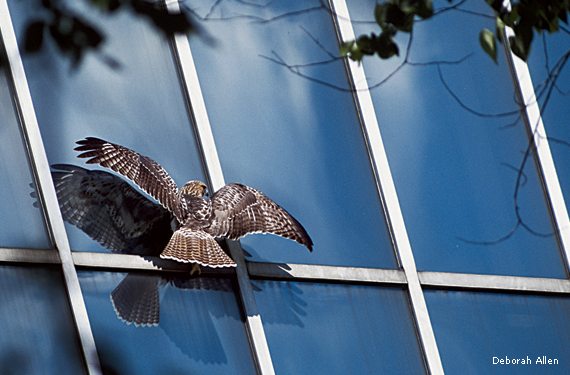Richmond adopts bird-safe building rules
By Ilana DeBare
The City of Richmond adopted a new zoning plan this month that includes standards for Bird-Safe Buildings — joining a growing number of Bay Area cities that are encouraging bird-safe building design.
The new rules require that windows greater than 24 square feet in size be treated in some way to prevent bird collisions. Birds can’t perceive clear glass, but they can be steered away by techniques that include fritted glass, ultraviolet patterns within the glass, mullions, shades, and louvers.
Golden Gate Bird Alliance worked with Richmond planning staff to develop the guidelines. They follow similar standards in San Francisco and Oakland, which were the first two cities in the country to adopt municipal bird-safe building rules.
The new rules are a particularly welcome development in Richmond, since the city has such an extensive waterfront, which draws tens of thousands of water and shorebirds each year, including many winter migrants. Across North America, it’s estimated that up to 1 billion birds die each year from window collisions.

“This is a great victory for the birds and for the people of Richmond who care about their wildlife,” said GGBA Executive Director Cindy Margulis.
Richard Mitchell, Planning Director for Richmond said:
“The adoption of these standards reinforces the City’s commitment to the environment by ensuring that new buildings are designed to reduce bird mortality from circumstances that are known to pose a high risk to birds and are considered to be bird hazards.”
With Golden Gate Bird Alliance raising the issue and providing input, San Francisco enacted the country’s first municipal bird-safe building standards in October 2012. Oakland followed suit in June 2013. Since then, Sunnyvale and Palo Alto have also passed bird-safe building standards, and cities such as Portland, Oregon, and Highland Park, Illinois, are currently considering them.

“We were fortunate that Richmond was working on updating their zoning and they were able to incorporate this new piece,” said Noreen Weeden, GGBA’s Conservation Project Manager, who started working with the city last March.
Approved by the Richmond City Council on November 15 as part of the new zoning plan, the standards apply to new construction and renovations. There is an exemption for small structures (less than 45 feet high) where glass makes up less than half of the facade, unless the building is in a “bird collision zone” adjacent to a park or body of water.
“This gives momentum to our program of getting rapidly-developing cities in the Bay Area to understand the importance of bird-safe building guidelines,” Margulis said.
Many of the window treatment options offer economic benefits as well as benefits for wildlife. For instance, the bits of sand embedded in fritted glass provide insulation that makes buildings more energy-efficient.
“There are simple, inexpensive ways to treat glass, and ways to incorporate energy-saving properties into glass or glazing that provide a long-term economic benefit,” Weeden said.
Want to bring bird-safe building standards to your city? Contact Noreen Weeden at nweeden@goldengatebirdalliance.org. Golden Gate Bird Alliance also offers AIA/CES-accredited training seminars for architects in options for complying with bird-safe building guidelines.
